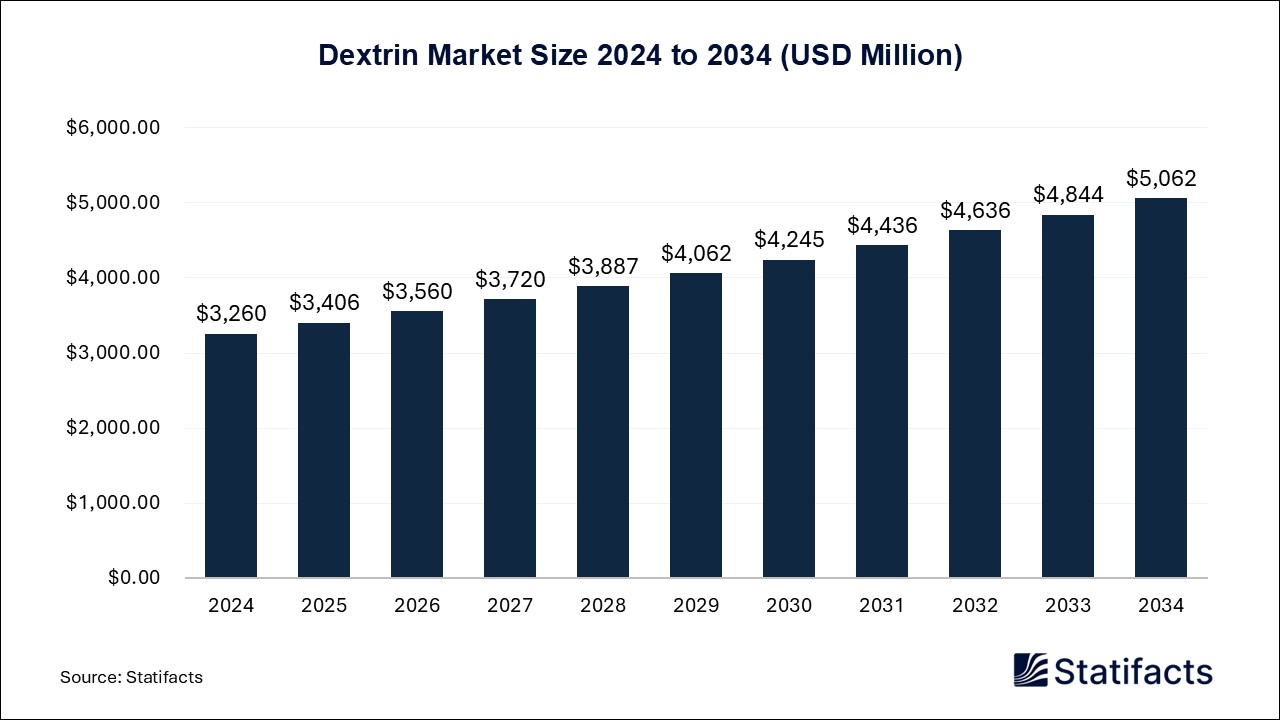Last Updated: 19 Jun 2025
Source: Statifacts
By clicking “Accept All Cookies” you agree to the storing of cookies on your device to enhance site navigation, analyze site usage, and assist in our marketing efforts.
Privacy PolicyThe global soil remediation market size was estimated at USD 44.9 billion in 2024 and is projected to be worth around USD 87.13 billion by 2034, growing at a CAGR of 6.85% from 2025 to 2034.
| Industry Worth | Details |
| Market Size in 2025 | USD 47.82 Billion |
| Market Size by 2034 | USD 87.13 Billion |
| Market Growth Rate from 2025 to 2034 | CAGR of 6.85% |
The soil remediation market talks about soil remediation, a process whereby removal of impurities from the contaminated soil takes place, through which the productivity of plants can be enhanced and the plants can be grown safely. This, in turn, helps other humans and the environment overall stay healthy. Some of the techniques of soil remediation include physical and chemical remediation, bioremediation, and phytoremediation.
There are various fields where this proves to be helpful. Some of the examples of the same encompass lessening the impact of climate change, cleaning up hazardous material, and keeping pollutants away from agricultural and industrial sites. The food on our table mostly contains fruits and vegetables, which need soil to grow in. This makes soil remediation all the more important for us humans.
More than 95 percent of the total food we have on our planet comes from soil. Additionally, 15 of the 18 naturally occurring chemical elements necessary for plants are supplied by the soil.
While encouraging the scientists' expertise at RemePhy and working on soil treatment, Thompson said: “Franklin and Ion’s innovative approach to sustainable soil remediation, combined with Imperial’s scientific excellence and our venture-building expertise, perfectly positions RemePhy to tackle this pressing global challenge. We are proud to support their journey in bringing this groundbreaking technology to market."
The soil remediation market has greatly benefited from the advent of artificial intelligence. In essence, AI transforms soil remediation from a reactive, trial-and-error process to a data-driven, proactive approach that optimizes resource use, minimizes environmental impact, and accelerates the restoration of degraded soils.
The global soil remediation market is experiencing significant growth, with North America maintaining its position as the dominant region while Europe emerges as the fastest-growing market. The APAC region is expected to grow in the coming years.
North America
The North American market is growing thanks to the introduction of advanced technologies for treating the soil in a better manner. Firms like Alterra IOS broadcasted the big opening of a $40 million soil cleanwashing facility in South Philadelphia, along with Eco Materials, to remediate the sand and other construction resources via an advanced wet washing process.
Europe
The market in Europe is expected to grow as a consequence of the companies persuading scientists to develop state-of-the-art technology to combat soil degradation. RemePhy, applying its innovative phytoremediation technology using plants to remove heavy metal pollutants from soil, enabling land to be restored, aims to overcome the soil contamination challenge.
APAC
The soil remediation market in the APAC region retained its triumphant stance, owing to the ministers of the government taking steps to conserve and restore soil for the purpose of farming. At the meeting of BRICS Agriculture Ministers, the ministers unveiled the BRICS Land Restoration Partnership to pay attention to issues like land degradation, desertification, and soil fertility loss, and support the farmers’ livelihood and protect the soil of India.
The soil remediation market is highly competitive, with leading pharmaceutical companies such as AECOM, Tetra Tech Inc., Clean Harbors, Golder Associates, Sevenson Environmental Services Inc., Environmental Works, Nelson Environmental Remediation, Delta Remediation Inc., and Envirocon holding the highest market share. Emerging biotech firms also play a crucial role by fostering a dynamic and evolving competitive landscape.
The market is dominated by several pharmaceutical companies renowned for their significant contributions to cancer research and treatment. Based on recent data, the top three leading companies are:
The yearly revenue of AECOM was accounted to be $16,105,498 in 2024.
The annual revenue of Tetra Tech Inc. was positioned at $5,198,679 in 2024.
The gross profit of Clean Harbors jumped from $1,663,028 in 2023 to $1,824,239 in 2024.
Published by Vidyesh Swar
Last Updated: 19 Jun 2025
Source: Statifacts
Last Updated: 19 Jun 2025
Source: Statifacts
| Subsegment | 2024 | 2025 | 2026 | 2027 | 2028 | 2029 | 2030 | 2031 | 2032 | 2033 | 2034 |
|---|---|---|---|---|---|---|---|---|---|---|---|
| Physical Methods | 15,209.10 | 16,118.40 | 17,097.60 | 18,153.00 | 19,291.10 | 20,519.40 | 21,845.70 | 23,279.00 | 24,829.00 | 26,506.20 | 28,098.60 |
| Chemical Methods | 18,489.60 | 19,563.00 | 20,717.20 | 21,959.10 | 23,296.10 | 24,736.50 | 26,289.20 | 27,964.20 | 29,772.10 | 31,724.90 | 33,581.10 |
| Biological Methods | 11,203.20 | 12,139.20 | 13,161.90 | 14,280.10 | 15,503.60 | 16,843.30 | 18,311.10 | 19,920.50 | 21,686.40 | 23,625.40 | 25,449.00 |
Last Updated: 19 Jun 2025
Source: Statifacts
| Subsegment | 2024 | 2025 | 2026 | 2027 | 2028 | 2029 | 2030 | 2031 | 2032 | 2033 | 2034 |
|---|---|---|---|---|---|---|---|---|---|---|---|
| Physical Methods | 15,209.10 | 16,118.40 | 17,097.60 | 18153 | 19,291.10 | 20,519.40 | 21,845.70 | 23279 | 24829 | 26,506.20 | 28,098.60 |
| Chemical Methods | 18,489.60 | 19563 | 20,717.20 | 21,959.10 | 23,296.10 | 24,736.50 | 26,289.20 | 27,964.20 | 29,772.10 | 31,724.90 | 33,581.10 |
| Biological Methods | 11,203.20 | 12,139.20 | 13,161.90 | 14,280.10 | 15,503.60 | 16,843.30 | 18,311.10 | 19,920.50 | 21,686.40 | 23,625.40 | 25449 |
Key trends include advancements in AI and robotics, which improve efficiency and reduce environmental impacts. Governments are also pushing for land restoration, and innovative techniques like phytoremediation are gaining traction.
AI optimizes remediation by predicting soil conditions, improving technique selection, and enhancing precision through robotics, making the process more efficient and sustainable.
The growth is driven by the need for sustainable agriculture, stricter environmental regulations, and technological innovations in remediation methods, particularly AI and biotechnology.
The market is competitive, with leaders like AECOM, Tetra Tech, and Clean Harbors dominating, while emerging biotech firms are innovating with new technologies, driving market dynamics.
With a projected market size growth from USD 47.82 billion in 2025 to USD 87.13 billion by 2034, the soil remediation market offers significant investment opportunities, driven by regulatory pressures and technological advancements.
Regulatory frameworks, such as the European Green Deal and U.S. government initiatives, are pushing for sustainable practices and driving demand for soil remediation technologies.
Future technologies will focus on AI, robotics, and biotech innovations, making soil remediation faster, more sustainable, and cost-effective.
Related Reports
To get full access to our Market Insights, you need a Professional Account or a Business Suite.

You will receive an email from our Business Development Manager. Please be sure to check your SPAM/JUNK folder too.

You will receive an email from our Business Development Manager. Please be sure to check your SPAM/JUNK folder too.

Our customers work more efficiently and benefit from


